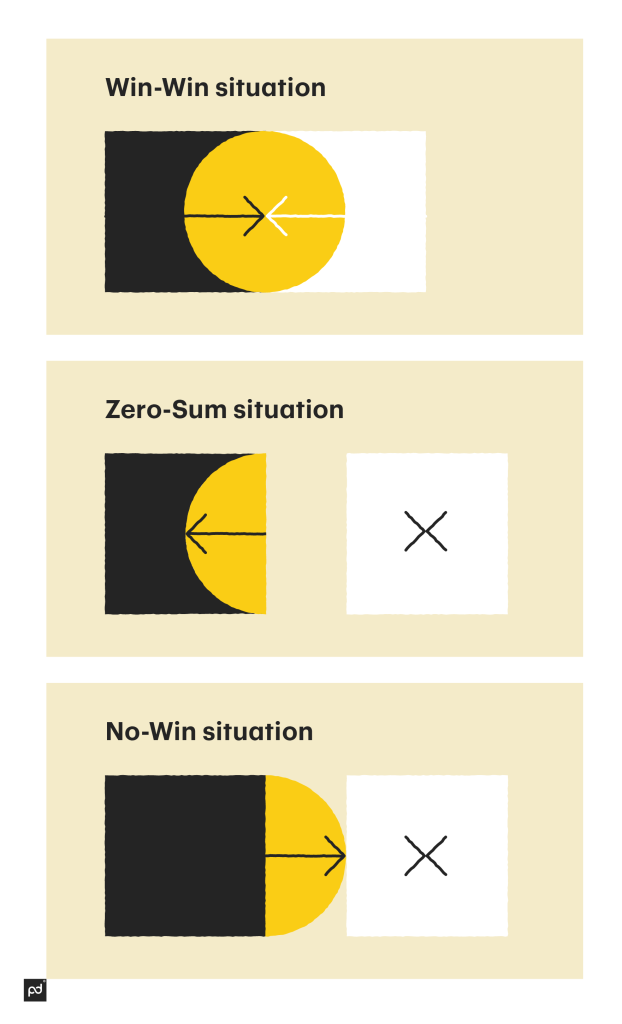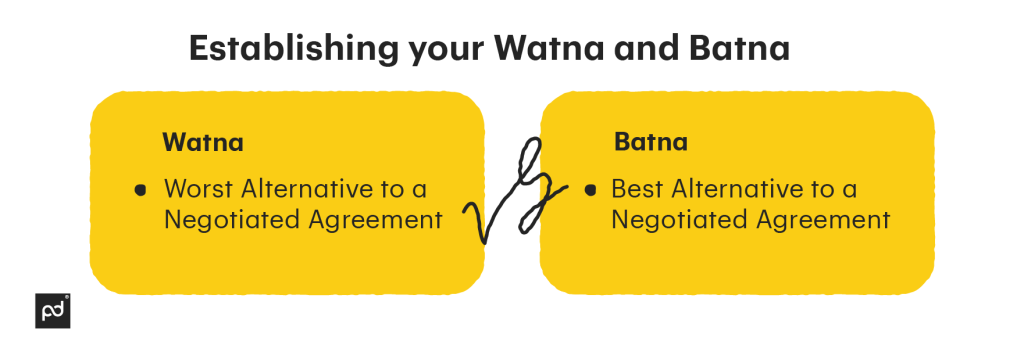A wide variety of possible price negotiation strategies exist but all of them have a common baseline. Customers often try to haggle at the last minute when it’s really too late to back out of previous agreements.
And it’s quite hard to overcome such attempts loss-free. That’s why successful bargaining requires special knowledge of negotiation tactics and advanced negotiation skills.
In this article, we’ll help you find answers to the most important questions that all business owners and salespeople should have in their arsenal when negotiating prices with their customers.
Expect to be much more efficient at the following:
- How do I negotiate the price politely?
- How do I deal with difficult customers?
- How do I overcome any attempts to lower prices?
- How do I respectfully encourage my customers to pay even more?
Moreover, you’ll find a couple of short theoretical points inserted throughout to help you dive into the fundamentals of negotiation, as well as a bunch of valuable tips for your sales team on how to bargain better.
Sales negotiations through the lens of game theory: Win-Win vs Zero-Sum vs No-Win explained
Game theory is a mathematical framework for modeling different social situations among competing parties or “players” in the “game.”
This theory offers a way how to present the negotiation part of a sales process as a set of simple and understandable categories (definitions), which are described below:
- Game (a set of events resulting in the decisions of two or more actors)
- Player (the decision-making actor of the game)
- Strategy (a set of choices of the decision-making actors during the game)
- Payoff (an outcome of each choice in a numerical form, where the higher numbers mean the more desirable outcome)
- Equilibrium (a resulting solution of the game payoffs).
As you can see, the game is a situation where the players each pursue a certain strategy, which results in a series of payoffs, and, finally, in certain equilibrium.
What is important for us is that there are different types of games in existence, based on angles of view. Two of them are crucial for understanding negotiations: cooperative and non-cooperative.
- A cooperative type of game is a type of game in which both parties benefit from the result.
- A non-cooperative type of game is a type of social situation in which only one party benefits from the game. The second party, in turn, does not benefit. Such games where one party gains what the other loses are the result of zero-sum situations.
Each healthy business relationship is built upon the mutual benefit of the involved parties, e.g. a cooperative type of game in terms of game theory.
These games result in win-win situations. And your goal is to ensure that the deal is mutually beneficial, and will lead to a win-win situation given the right circumstances.
On the other hand, all attempts of late-stage bargaining must be shown as potential triggers of zero-sum or even no-win situations.
The last one happens when the main goal of one party is to not let others win at all costs. And, once a chance of victory is lost, they try to force the other parties to lose, too.
We’ve prepared an infographic that illustrates how different types of negotiations correlate with each other in terms of game theory.
You can also find more about game theory at Investopedia.

How to negotiate prices while staying polite and positive
The negotiation process is often stressful and exhausting. If we speak about the deals that cost millions of dollars, the process usually has multiple stages and involves various people from both sides.
As a result, maintaining composure while closing the deal isn’t easy, especially for those less experienced.
Within our extensive experience in the sales field, we understand the power of negotiation. Here are some of the things we’ve learned along the way that we’d like to share with you.
Between good and evil: a balanced approach
A certain dilemma about “tone” exists when it comes to negotiations. On one hand, being polite during negotiations can be considered by the other party as a weakness, with failure the corresponding result.
On the other hand, however, no one wants to look like a tyrant in another’s eyes even if it is a way to succeed at times.
We’ve synthesized our own balanced approach, helping you firmly take a stand but remain polite and kind at the same time.
Here are nine general tips on how to balance between good and evil during your negotiations.
1. Don’t focus on the deal itself
In other words, closing the deal mustn’t be your primary goal. And your opponent should understand this, of course.
Yes, it’s easy for us to advise you to forget about closing while everything may still be tense.
But some document tracking might help you stay aware of each time when the second party opens, views, or changes any of the documents to predict their future outcome.
2. Don’t focus on the price either
Instead, keep in mind the things that add value to your proposition.
While you’re discussing these additional values, it’ll be that much harder for your opponent to bid the price down, right?
3. Be ready to push back
The possibility of you rejecting the deal in case of disadvantageous conditions must be as crystal clear for you as it is for your opponents.
Otherwise, it’ll be considered a weakness on your part, and will surely be used against you.
4. Be polite but remain firm
Sounds obvious, but this is one of the classic errors of newbie negotiators — they easily lose their composure under the pressure, which makes them weaker in the opponent’s eyes.
Don’t show that you’re willing to back down to avoid confrontation. And remember, self-confidence is your main ally in negotiating contracts.
5. Dive deep into all aspects of the price negotiation as much as possible
Ask your opponent questions and listen to their responses carefully, rather than continually repeating the same statement about your position.
Each new fact your opponent says can become efficient leverage in the negotiations. Moreover, such an open approach helps win people’s favor.
6. Focus on mutual purpose and common features
Now, it’s time to remember what we’ve learned about win-win situations. In the ideal world, your deal must always be mutually beneficial.
But even if the real situation is slightly different, there is always enough room for finding common ground here. A good practice here is the active usage of “We” instead of “I” in your discussions.
7. Evaluate the negotiation from different angles, especially your opponent’s point of view
The better you understand the second party, their real desires, needs, and problems, the better chance you’ll have of sealing the deal.
8. Use small talk
Informal discussions will definitely help you learn more valuable details about the opponent. Try to speak more about their interests, personal intentions, what they like, etc.
This not only helps you find the right context but also helps win the favor of your opponents.
9. Be creative
Try finding the things which cost you less but look very valuable in the eyes of your opponents.
For example, you can offer additional support, training for their staff, or an expanded warranty within the same price.
These are just several examples of how you can improve your position in the negotiation by simply being more creative.
Dealing with really difficult customers
We bet each and every salesperson has met customers who really were a pain.
Some of them simply have such a bad temper; others, though, are just bent on manipulating you this way. In both cases, it’s important to keep the situation under control.
Below are some short but valuable tips on how to act when negotiating with such unpleasant opponents.
1. Free yourself from your fears
There are several common fears that exist in negotiations: fear of negative results; fear of ruined relationships; fear of challenging the opponent; fear that your solution won’t solve the customer’s issues.
Each and every one of these during the negotiation works to your disadvantage. Our article How to respond to an RFP with no fear will give you several valuable pointers on how to overcome your fears.
2. Remain calm
The less stable your mind is during the negotiations, the worse your chance to succeed. Negotiators who act aggressively and deliberately will surely sense as much and try getting under your skin.
And, in the case of a successful provocation, you’ll risk losing not only your deal but also the reputation of your company.
Keeping calm is only possible when you’re sure that all the technical aspects are under control, too.
3. Use reflective listening and repeat the words of your customer
Reflective listening is a technique that helps both parties in the negotiation stay on the same page and understand each other better.
Usually, such a practice starts with an expression like “Did I correctly understand that…”, and continues with your interpretation of your opponent’s statement.
4. Take into account an affect heuristic
The affect heuristic reflects the relationship between emotions and the decision-making process. Here are two main thoughts about the affect heuristic:
- Positive emotions lead people to overestimate the role of benefits and underestimate risks. Negative emotions, in turn, affect people the opposite way.
- The more powerful your emotions are, the stronger they distort your thinking.
It is crucial to take this heuristic into consideration during your negotiations. Sometimes it could be the only way to a successful resolution.
5. Understand the nature of anger
Remember that anger is a natural emotion both you and your opponent can face during the negotiations.
Always keep in mind that justifying your position in response to your opponent’s anger is rarely, if ever, a good option. Don’t take the opponent’s anger personally.
The best option is to understand the cause of anger and then pause your negotiations until you’ll find a solution, and your opponent will cool off.
6. Be sincere and explain how you intend to proceed with the next steps
Negotiating professionals have a subtle feeling about sincerity.
And, should you be dealing with one, when they’re being spoken to in any inadequate manner, it likely worsens the situation for you across all negotiations. That’s why you must choose your tone of voice and words very carefully.
Explaining your further steps acts as an efficient way to improve the trust level between you and your customer, making them calmer.
Moreover, a clear understanding of your further actions and their goals leaves much less room for your opponent to effectively negotiate the price.
7. Use active listening and a “beginner’s mind”
The active listening approach requires the next four steps:
- A thorough listening itself
- A reflection of the words spoken
- A validation through repeating
- Asking any and all relevant questions.
As you can see, some of these steps are pretty obvious, while the others were already described above in our article.
The beginner’s mind (or Zen mind) helps analyze the words of your opponent, validate them, and then to ask proper questions.
This technique means you approach the situation as if you are absolutely new to it. The technique makes you free of any prejudices that can come from your previous experience.
Just ask questions and listen to answers, coupling them with new questions as appropriate.
8. Deconstruct issues
The process of breaking things down makes it easier to divide issues into smaller and simpler ones. This provides a better understanding of how to solve them.
The resulting effort required for solving all the issues when disassembled is usually far lower than what would have been required to solve the initial issue as a whole.
9. Use any additional resources at your fingertips
There are some special tricks that can simplify your troubled customer negotiations:
- Ask a colleague for an additional review/confirmation/research/any other action. This trick will help you attract allies in case you need them.
- Pause the negotiations under a formal excuse. This can help you buy additional time for lowering the negative emotions of your opponent, or for reconsidering your position in negotiations. A similar approach is quite common for courts where the lawyers, prosecutors, and often judges use it actively for getting additional time.
- Use screen sharing or recording options. Such tools can help you be more decisive.
10. Be thankful
Don’t forget to be thankful even if your customer is not. It’s free and can help in your negotiations going forward.
For example, understanding “BATNA and WATNA” is one of the most efficient ways of de-escalating tensions.
BATNA and WATNA: your two great allies

The BATNA and WATNA concepts are parts of a negotiation theory offered by Harvard’s Program on Negotiation (PON) researchers Roger Fisher and William Ury.
BATNA means the best alternative to a negotiated agreement, while WATNA is about the worst one.
Let’s assume you’re selling a potential customer your shiny rare version of a BMW. The warranty period has just passed, so your desired price is much lower than for the younger cars of the same model.
Also, only one car of the same version is currently selling for a price equal to your desired one. But its condition is ugly — which makes that deal much less attractive.
Your potential customer, in turn, offers you an even lower price. At the same time, there is one more potential buyer who’s ready to buy your car at the price higher than the first customer offers but lower than your desired one.
So, you can, instead of selling your car to the first customer at the price they offered:
- Sell the car to the second customer for a higher price.
- Halt selling and keep the car until you’ll find the customer who’ll be ready to pay your desired price.
Your first potential customer can, instead of buying your car at the price they offered:
- Buy an alternative car for the same price as your car.
- Halt buying and keep the money until they’ll find the car in the required conditions and at the desired price.
In our example, BATNA for you is to sell the car to the second customer, and WATNA is to halt selling. For your opponent, BATNA is to stop buying, and WATNA is to buy the worst alternative for more money.
As you can see, the art of negotiation strategy here is to create a situation with the best possible BATNA for you and no acceptable BATNA for your opponent.
In our example, this means that the opponent, as an alternative to the deal, can only buy a rust bucket for the same amount of money, while you have a potential buyer who’s ready to buy your car for a higher price.
Just make sure that both parties are aware of these conditions, and your deal will suddenly become halfway (or even closer) to success.
How not to lower the price, stop any lowering attempts, or even increase it
How to tell your customer that the price you’ve offered is final
The short answer is “There is no universal recipe that forces your customer not to bargain.” Actually, you can ask whatever you want a whole bunch of times but you cannot disallow them anything.
So, if the customer wants to bargain, they will. But if you prefer lowering your price rather than defending it, you will likely lose respect from your customers and sign the deal on disadvantageous terms.
It’s better if you can minimize their chances of success.
Here are some tips on how to do just that:
- The initial price offer must come from the seller not from the buyer, instead of a widespread opinion.
- Offer concrete numbers rather than price ranges. This makes your price less open to discussion in the opponent’s eyes. When the customer sees the range instead of an accurate number, they will often consider its lowest end as the starting point for the bargain.
- Define your desired price rather than thinking about what price will be acceptable for the customer.
- Define the threshold below which the price will be considered unacceptable and the deal will be rejected.
- Prioritize your interests. For example, your main priority is to first get traction, so the price here is secondary. Or, you’ve done enough continuous collaboration and are ready to cut the price in order to sign the long-term agreement. Or, you’re currently experiencing shortages with your operating assets, so profit margin size is crucial.
- Ahead of the negotiation, define the points which you’ll use. It could be customers’ pain points; the values of your product or service correlating with the customers’ needs; known weaknesses of the second party; or any other information you could use as weapons in the negotiation process.
Concluding with all that’s mentioned above, there are several tips on how to keep the price constant against all bargaining attempts.
But none of the tips acts as a silver bullet, nor does any of them guarantee the desired result.
On the other hand, lowering the price on each demand rather than negotiating will probably lead to even worse results.
Techniques on how to encourage customers that what you’re selling is worth even more
Speculating (and then executing) on raising your price when your customer is dreaming the opposite is a real art. But there are several rules and tips which make this art become possible.
1. Explain the value of each dollar
Understand and be willing to explain the value of each dollar your customer has to spend on your product or service.
In other words, your customer should clearly see the benefits they gain and can compare them with the required spending.
2. Suspend a sales negotiation
Be ready to suspend a sales negotiation at any given moment once something goes south. Of course, your customer must be aware of your willingness.
3. Don’t even think about selling short
Don’t even think about selling short and never apologize for the price. You must be fully confident of the quality and value of your product or service.
Don’t apologize for the price, ever — otherwise your opponent will consider it questionable and surely will start bargaining.
4. Set exchange rates for any potential discount
Set exchange rates for any potential discount. The thinking here must be, “Ok, we’re ready to cut the price exclusively for you. But you should give us something in return.”
Such a return can be an extended contract, letter of intent about further collaboration, reference to another potential customer, etc. The main thought here is that discounts aren’t free.
How to justify your price:
- Make the price legitimate and within the current market value. Just state that the price is within the market and reasonable for the feature set offered.
- Present your product or service as a combination of values for the customer. It’ll help you switch the discussion from the price itself to the values of your product or service.
- Convey to your customers that the price is clear and standard for everybody, which makes it unable to change for any given customer.
Three typical tactics of a buyer and how to deal with them
Among several creative approaches to bargaining, there are three that are the most typical and popular. We’ve outlined these basic tactics, along with possible actions to overcome them.
1. False flinch
The customer shows a heavy surprise once you’ve disclosed your price but without any attempts of lowering it.
This may be followed with some expressions like “Are you sure?!!”,
“Your price looks shocking!”, etc. The best strategy here is not to react at all — making a counteroffer is a losing strategy against this tactic.
2. Squeezing
Once you’ve told the price, the customer starts to bargain aggressively using statements like “I know this costs less” or “I require a discount.”
Your best reaction must be whether to switch focus from the price to the value of the product or service or to offer a discount only in exchange for something.
3. Crying the blues
The customer says that the certain amount (which is lower than the price you’ve offered, of course) is everything they have.
You should ignore this lament as a bluff or ask the customer to reconsider their budget in order to get the required amount from the other sources.
Once you start analyzing your own negotiations, you’ll find out that most attempts are pretty similar to each other.
That’s why the tips presented above are universal and potentially helpful in almost every situation.
What we’ve learned today
As you can see, negotiation is, on one hand, a kind of magic — but it’s also a thing you can influence a lot. Let’s wrap up with an overview of what we’ve covered today.
- There is no guaranteed cure against bargaining — and that’s OK
- The elements of game theory are useful for delving into how negotiations work
- It is quite easy to lose politeness during price negotiations
- It is also very important to maintain politeness without falling into the trap of being (or being perceived as) a pushover — that’s why the balanced approach is best
- You must be able to deal with the most troubled customers; there are a couple of proven approaches that exist
- With enough experience, you can even increase the price during negotiations that started as an attempt to lower it
- Instead of a bunch of different negotiation techniques, there are three main methods that are used most of the time.
Most of the aspects that influence bargaining lay outside technology, and are more about psychology and communication.
However, some technological advancements like PandaDoc Contract Negotiations features can help make the process much smoother, faster, and more predictable.
You can find some valuable practical tips on how to handle contract negotiations using PandaDoc within your sales team, and how to start using our Contract Negotiations feature.
Originally published August 31, 2016, updated September 27, 2022
Disclaimer
PandDoc is no PandDoc is not a law firm, or a substitute for an attorney or law firm. This page is not intended to and does not provide legal advice. Should you have legal questions on the validity of e-signatures or digital signatures and the enforceability thereof, please consult with an attorney or law firm. Use of PandaDocs services are governed by our Terms of Use and Privacy Policy.


